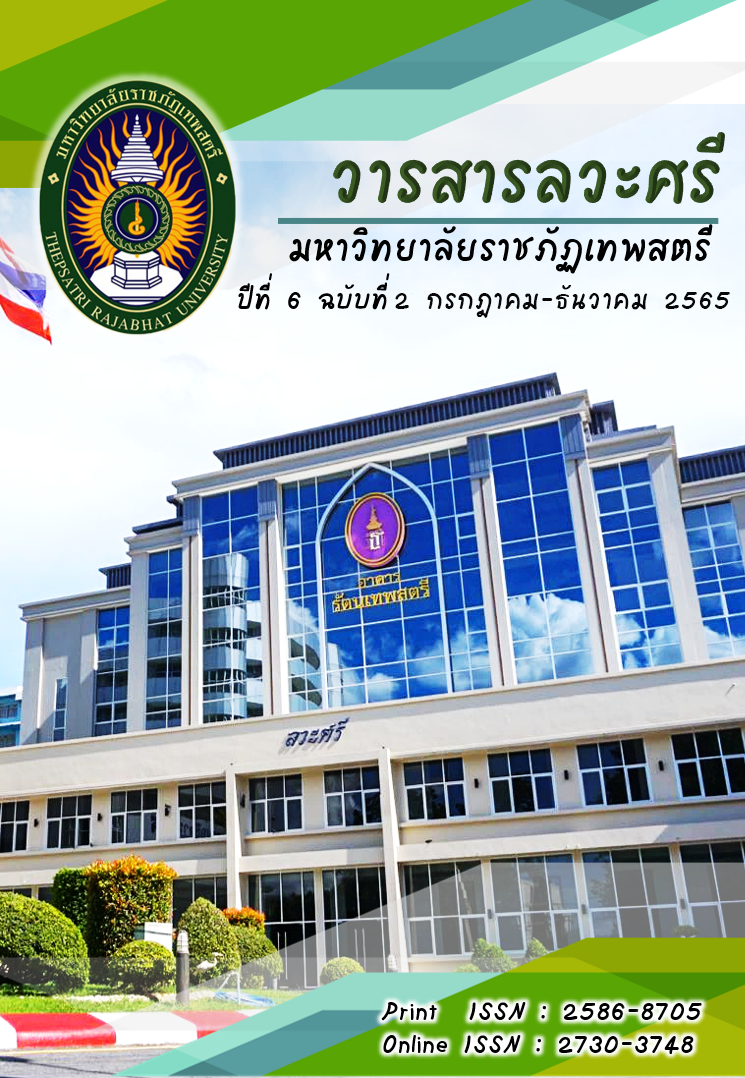ปัจจัยที่ส่งผลต่อความตั้งใจใช้บริการอย่างต่อเนื่อง และการบอกต่อของลูกค้าที่ใช้บริการสั่งอาหารทางออนไลน์ในเขต กรุงเทพมหานคร
คำสำคัญ:
คุณภาพการให้บริการ, คุณค่าที่รับรู้ด้านคุณภาพ, คุณค่าที่รับรู้ด้านราคา, ความตั้งใจใช้บริการอย่างต่อเนื่อง, การบอกต่อบทคัดย่อ
การวิจัยนี้มีวัตถุประสงค์เพื่อพัฒนาโมเดลความสัมพันธ์เชิงสาเหตุปัจจัยที่ส่งผลต่อความตั้งใจใช้บริการอย่างต่อเนื่อง และการบอกต่อของลูกค้าที่ใช้บริการสั่งอาหารทางออนไลน์ในเขต กรุงเทพมหานคร ผู้วิจัยดำเนินการวิจัยโดยทำการวิจัยเชิงปริมาณ เป็นการวิจัยเชิงประจักษ์ ใช้แบบสอบถามเป็นเครื่องมือในการเก็บรวบรวมข้อมูลจากลูกค้าที่ใช้บริการสั่งอาหารทางออนไลน์ในเขตกรุงเทพมหานคร จำนวน 424 คน สถิติที่ใช้ในการวิเคราะห์ข้อมูล ได้แก่ การแจกแจงความถี่ การหาค่าเฉลี่ย การหาค่าร้อยละ การหาค่าส่วนเบี่ยงเบนมาตรฐาน และการวิเคราะห์โมเดลสมการโครงสร้าง
ผลการวิจัยพบว่า (1) คุณภาพการให้บริการ คุณค่าที่รับรู้ด้านคุณภาพ และคุณค่าที่รับรู้ด้านราคามีอิทธิพลทางบวกต่อการใช้งานระบบ (2) คุณภาพการให้บริการ คุณค่าที่รับรู้ด้านคุณภาพ คุณค่าที่รับรู้ด้านราคา และการใช้งานระบบมีอิทธิพลทางบวกต่อความพึงพอใจของลูกค้า (3) การใช้งานระบบ และความพึงพอใจมีอิทธิพลทางบวกต่อความตั้งใจใช้บริการอย่างต่อเนื่องของลูกค้า และ (4) การใช้งานระบบ และความพึงพอใจมีอิทธิพลทางบวกต่อการบอกต่อของลูกค้า
เอกสารอ้างอิง
เกตุวดี สมบูรณ์ทวี. (2561). ปัจจัยด้านคุณภาพการบริการที่มีอิทธิพลต่อการตัดสินใจซื้อซ้ำผลิตภัณฑ์อาหารผ่านผู้ให้บริการ “Food Panda Application”. วารสารการจัดการสมัยใหม่, 16(1), 153-162.
ชุติกาญจน์ ศิริวิมลวรรณ, อัมพล ชูสนุก, และวทัญญู รัศมิทัต. (2562). อิทธิพลของคุณภาพการให้บริการ ความปลอดภัย และความง่ายในการใช้งานต่อการใช้งานระบบ ความพึงพอใจ ความตั้งใจใช้บริการอย่างต่อเนื่อง และการบอกต่อของลูกค้าแอพพลิเคชั่น MyMo ของธนาคารออมสิน. Veridian E-Journal Silpakorn University ฉบับภาษาไทย สาขามนุษยศาสตร์ สังคมศาสตร์ และศิลปะ, 12(5), 1427-1444.
รุ่งนภา เสถียรนุกูล. (2561). O2O จากออนไลน์สู่ออฟไลน์ เทรนด์การตลาดยุคใหม่่ในโลกดิจิตอล. ค้นเมื่อ 27 มกราคม, 2565, จาก https://mgronline.com/mutualfund/detail/ 9610000005429
วทัญญู รัศมิทัต, นรพล จินันท์เดช, อัมพล ชูสนุก และดนุวศิน เจริญ. (2561). ปัจจัยที่ส่งผลต่อการใช้งาน ความพึงพอใจ ประโยชน์สุทธิ และการบอกต่อของผู้ใช้งานสมาร์ทโฮมผ่านสมาร์ทโฟนในเขตกรุงเทพมหานคร. เศรษฐศาสตร์และบริหารธุรกิจปริทัศน์, 14(2), 42-57.
Anderson, E. W., Fornell, C., & Lehmann, D. R. (1994). Customer satisfaction, marketshare, and profitability: Findings from Sweden. Journal of Marketing, 58(3), 53-66.
Bachunan, L., Simmons, C. J., & Bickart, B. A. (1999). Brand equity dilution: Retailer display and context brand effects. Journal of Marketing Research, 36(3), 345-355.
Belanche, D., Flavián, M., & Pérez-Rueda, A. (2020). Mobile Apps Use and WOM in the Food Delivery Sector: The Role of Planned Behavior, Perceived Security and Customer Lifestyle Compatibility. Sustainability, 12(10), 4275.
Bernarto, I., & Purwanto, A. (2022). The Effect of Perceived Risk, Brand Image and Perceived Price Fairness on Customer Satisfaction. Brand Image and Perceived Price Fairness on Customer Satisfaction, XXVI(1), 35-50.
Chayomchai, A. (2021). Effects of service quality, satisfaction, and perceived loyalty in technology use of generation z consumers during the Covid-19 situation. Journal of Southwest Jiaotong University, 56(4), 300-310.
Deb, S., & Ahmed, M. A. (2018). Determining the service quality of the city bus service based on users’ perceptions and expectations. Travel Behaviour and Society, 12, 1-10.
DeLone, W. H., & McLean, E. R. (2003). The DeLone and McLean model of information system success: A ten-year update. Journal of Management Information Systems, 19(4), 9-30.
El-Adly, M. I. (2019). Modelling the relationship between hotel perceived value, customer satisfaction, and customer loyalty. Journal of Retailing and Consumer Services, 50, 322-332.
Errajaa, K., Hombourger-Barès, S., & Audrain-Pontevia, A.-F. (2022). Effects of the in-store crowd and employee perceptions on intentions to revisit and word-of-mouth via transactional satisfaction: A SOR approach. Journal of Retailing and Consumer Services, 68, 103087.
Franque, F. B., Oliveira, T., & Tam, C. (2021). Understanding the factors of mobile payment continuance intention: empirical test in an African context. Heliyon, 7(8), 1-12.
Hair, J. F., Babin, B. J., Anderson, R. E., & Black, W. C. (2019). Multivariate data analysis (8th ed.). India: Cengage.
Hellier, P. K., Geursen, G. M., Carr, R. A., & Rickard, J. A. (2003). Customer repurchase intention: A general structural equation model. European Journal of Marketing, 37, 1762-1800.
Juliana, J., Djakasaputra, A., Pramono, R., & Hulu, E. (2021). Brand Image, Perceived Quality, Ease of Use, Trust, Price, Service Quality on Customer Satisfaction and Purchase Intention of Blibli Website With Digital Technology As Dummy Variable in the Use of Eviews. Journal of Critical Reviews, 7(11), 3987-4000.
Kapo, A., Turulja, L., Zaimović, T., & Mehić, S. (2021). Examining the effect of user satisfaction and business intelligence system usage on individual job performance. Management: Journal of Contemporary Management Issues, 26(2), 43-62.
Koklic, M. K., Kukar-Kinney, M., & Vegelj, S. (2017). An investigation of customer satisfaction with low-cost and full-service airline companies. Journal of Business Research, 80, 188-196.
Marketeer Team. (2021). เจาะอินไซด์ Food delivery มีโอกาสเติบโตมากแค่ไหน. Retrieved Januray 26, 2022, from https://marketeeronline.co/archives/238462.
Meilatinova, N. (2021). Social commerce: Factors affecting customer repurchase and word-of-mouth intentions. International Journal of Information Management, 57, 1-12.
Nunnally, J. C. (1978). Psychometric theory (2nd ed.). New York: McGraw-Hill.
Oliver, R. L. (1997). Satisfaction: A behavioral perspective on the consumer. New York: McGraw-Hill.
Othman, B., He, W., Huang, Z., Xi, J., & Ramsey, T. (2021). The effects on service value and customer retention by integrating after sale service into the traditional marketing mix model of clothing store brands in China. Environmental Technology & Innovation, 23, 1-13.
Parasuraman, A., Zeithaml, V. A., & Berry, L. L. (1988). SERVQUAL: A multiple item scale for measuring consumer perceptions of service quality. Journal of Retailing, 64, 12-40.
Ramayah, T., Ling, N. S., Taghizadeh, S. K., & Rahman, S. A. (2016). Factors influencing SMEs website continuance intention in Malaysia. Telematics and Informatics, 33(1), 150-164.
Shahzad, A., Hassan, R., Aremu, A. Y., Hussain, A., & Lodhi, R. N. (2021). Effects of COVID-19 in E-learning on higher education institution students: the group comparison between male and female. Quality & Quantity, 55(3), 805-826.
Sweeney, J. C., & Soutar, N. G. (2001). Consumer perceived value: The development of a multiple item scale. Journal of Retailing, 77(2), 211-213.
Tam, C., & Oliveira, T. (2016). Understanding the impact of m-banking on individual performance: DeLone & McLean and TTF perspective. Computers in Human Behavior, 61, 233-244.
Veeramootoo, N., Nunkoo, R., & Dwivedi, Y. K. (2018). What determines success of an e-government service? Validation of an integrative model of e-filing continuance usage. Government Information Quarterly, 35(2), 161-174.
Wu, W.-N. (2021). Does citizens’ 311 system use improve satisfaction with public service encounters?—Lessons for citizen relationship management. International Journal of Public Administration, 44(8), 665-673.
Xie, C., & Sun, Z. (2021). Influence of perceived quality on customer satisfaction in different stages of services. Nankai Business Review International, 12(2), 258-280.
Yousaf, A., Mishra, A., & Gupta, A. (2021). ‘From technology adoption to consumption’: Effect of pre-adoption expectations from fitness applications on usage satisfaction, continual usage, and health satisfaction. Journal of Retailing and Consumer Services, 62, 1-12.
Zahra, J., Lukmantoro, T., & Ayun, P. Q. (2022). The Relationship Between Shopee’s Brand Awraness, Brand Association And Perceived Quality Towards Shopee’s Customer Satisfaction Among Indonesian Young-Adults. Interaksi Online, 10(3), 406-418.
ดาวน์โหลด
เผยแพร่แล้ว
รูปแบบการอ้างอิง
ฉบับ
ประเภทบทความ
สัญญาอนุญาต
ลิขสิทธิ์ (c) 2022 วารสารลวะศรี

อนุญาตภายใต้เงื่อนไข Creative Commons Attribution-NonCommercial-NoDerivatives 4.0 International License.
บทความ ข้อมูล เนื้อหา รูปภาพ ที่ได้รับการตีพิมพ์ในวารสารลวะศรี มหาวิทยาลัยราชภัฏเทพสตรี ถือเป็นลิขสิทธิ์ของวารสารลวะศรี หากบุคคลหรือหน่วยงานใดต้องการนำทั้งหมดหรือส่วนหนึ่งส่วนใดไปเผยแพร่ต่าหรือกระทำการใดๆ จะต้องได้รับอนาญาตจากวารสารวิชาการ ฯ ก่อนเท่านั้น เนื้อหาและข้อมูลในบทความที่ตีพิมพ์ในวารสารลวะศรี มหาวิทยาลัยราชภัฏเทพสตรี ถือเป็นข้อคิดเห็นและความรับผิดชอบของผู้เขียนบทความโดยตรง ซึ่งกองบรรณาธิการวารสารไม่จำเป็นต้องเห็นด้วย หรือร่วมรับผิดชอบใดๆ



